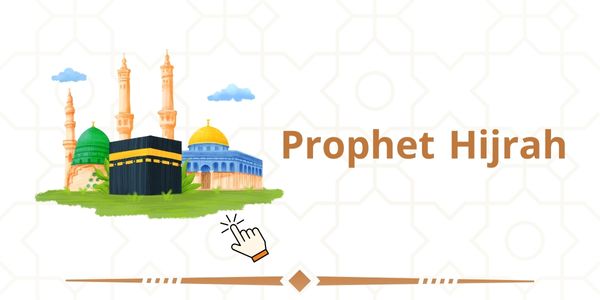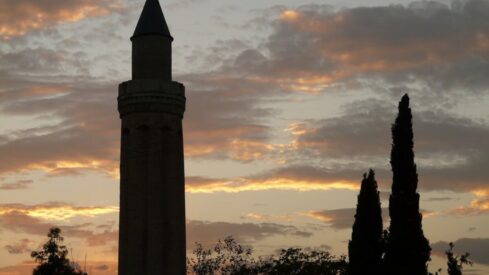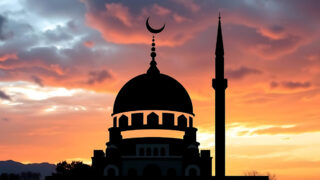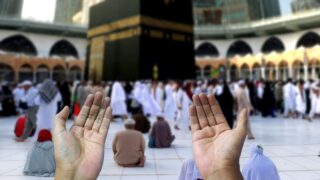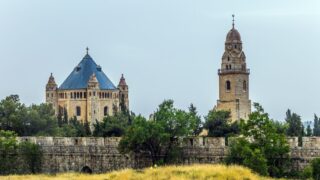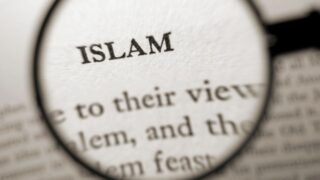It was a spiritual odyssey of over thirty years that took me from my Irish-Catholic-American roots through agnosticism and New Age metaphysics to Islam. It was only in Islam where I found the answers to all my questions and the peace which I had been seeking for a lifetime. It was also in Islam where I found solace and sanctuary, friendships and brotherhood, a new life, a spiritual home and Allah in the fall of 1992.
In 1990, at the age of forty-five, I returned to graduate school at the University of Arizona to begin my studies for a Ph.D. in Modern British Empire History and Near Eastern Studies. This was the realization of a dream I’d had since obtaining my M.A. in British and European history twenty-one years earlier. At that time, in 1969, I had passed up pursuing a Ph.D. program at Brown University to raise a family and take some time off from school. It was at the University of Arizona through my studies of Middle East and India that I once again came in contact with Islam.
From the time I was three until eighteen, my father’s position as an executive with the California-Texas Oil Company (Caltex) took our family to live and travel all over the world. Our first overseas assignment in 1949, when I was three, was in Bahrain in the Persian Gulf, where my parents, brother and I lived for five-and-a-half years. From there we moved to London for a short time before moving to India in 1956. Once in India, because there was no American schooling available locally, my parents sent me to Kodaikanal, an American Protestant missionary boarding school 600 miles to the south, where I attended school from the 5th to 10th grades. As one of the few Catholics at Kodaikanal International School, I learned much about Christianity — my own Catholicism — included, which began a lifelong interest in the subject as well as religion in general. However, my Catholic father became more concerned about my “Protestant” education and, mid-way through 10th grade, transferred me to an American international Catholic boy’s school in Rome, Italy. So, it was from Notre Dame International School in Rome that I graduated from high school two-and-a-half years later in June 1963.
Rome was a fascinating place to learn more about my religion, especially after the “negative” perceptions I’d received about Catholicism from some of my Protestant classmates at the missionary school. It was also a time of historic changes in the Catholic Church at the Second Vatican Council, some of which I was able to witness in person, or learn about from the Catholic prelates who came and spoke at the school. On my own, I also got to meet a cardinal, some bishops and archbishops attending the Council and had a papal audience with the charismatic and very dynamic ecumenical Pope John XXIII. (Ten years earlier, my parents, brother and I had had a private audience with Pope Pius XII and spoken directly with the Pope at his summer retreat at Castello Gondolfo.) By the time I left Rome, I was thoroughly entranced with my Catholic faith and planning on becoming a priest.
Meanwhile, because of my father’s executive position with Caltex Oil Company — both in India and in Germany, where my parents moved in 1962 — when at home or during vacations I met a number of important government, business and political leaders from all cultural backgrounds who were frequent guests in our home.
However, as I look back, it was as a five-year-old in Bahrain and later as a young man in India, where the sight of Muslims at prayer and the muezzin’s call to prayer made the most lasting impression of all my overseas experiences. Just hearing the adhan excited me. It made me feel good inside (as it still does today) and, no matter what I was doing, I always paused to listen whenever I heard it. Little did I know at the time that the adhan would later become such an important part of my life.
Still, it took some time for this to sink in. It was only after moving back to the States, going to college and graduate school, raising a family and having a twenty-year business career, when I returned to graduate school and once again became acquainted with Islam. This time, however, it was in an academic setting and through books and class lectures. Once “hooked” on Islam, I eagerly and voraciously read anything and everything I could get my hands on in English on the subject. I bought and devoured all the books I could find. Many were written by western Islamic scholars, themselves converts to Islam like Muhammad Asad, Martin Lings, Victor Danner, and Mohammad Marmaduke Pickthall. The fact that there were Western converts to Islam of this caliber further piqued my interest and curiosity. After much reading and study, I sensed a strong, growing affinity with Islam and a complete and total agreement with all its teachings in everything I read.
At the end of the summer, my UCLA friend suggested I read Muhammad Asad’s The Road to Mecca and get a copy of his translation and commentary of the Holy Qur’an. Asad was an Austrian-Polish Jew (Leopold Weiss) who converted to Islam and became a close friend of Abdul Aziz Ibn Sa`ud, founder of Sa`udi Arabia, in the 1920s. Among his many other activities over the years, including being a student and the close friend of Pakistan’s Sir Muhammad Iqbal, Asad became a renowned Arabic and Qur’anic scholar. However, it was reading Arberry’s translation of the Holy Qur’an that summer and realizing no man could have written it that did it for me. I finished reading Asad’s Road to Mecca in mid-October, just before attending the Annual Meeting of the Middle East Studies Association in Portland, Oregon, where I was to give a paper.
As it turned out, the meeting became a reunion of sorts for me with my summer school friends, as both the Canadian Muslimah and my Muslim friend from UCLA were also giving papers at the same conference. Almost as soon as we ran into each other at a bookstore in Portland near the conference site, the Muslimah asked me pointblank, “When are you going to become a Muslim?” I could only respond that I guessed I already was one in my heart and mind. Without a pause, she suggested that I make shahadah right then and there. I hemmed and hawed, but could find no reason not to do so. So, right then and there, in the “new arrivals” section of Powell’s Bookstore in Portland, Oregon, with another Canadian Muslimah as a witness, I made my shahadah. Not long afterwards, I left the bookstore and walked to my room at a nearby dorm. I was in a state of euphoria and incredible joy, feeling as if I was walking two feet above the ground. Later, when I saw my friend from UCLA and told him what had happened, and showed him the Qur’an I’d received from our Muslimah friend, he was overjoyed, hugged me warmly and welcomed me to Islam as his brother.
Two weeks later, on November 13, I once again recited the shahadah at Jumu‘ah prayers at the Islamic Center of Tucson. This time it was in front of several hundred people, after which I found myself at the front of a receiving line, where I was welcomed into the Islamic community with hugs and kisses from about 40 Muslim brothers in the most moving forty-five minutes of my life. It was an experience that still lives with me.
Attributing some of the final steps towards Islam to Muhammad Asad’s book, I decided to take his name as my Muslim name. Since he was a convert to Islam like me, I felt his name would also be a good name for me and, hopefully, I would become a good Muslim and scholar like him. However, once back at the University of Arizona, both my Arabic and Islamic history professors to whom I told my story suggested I change my name to Muhammad As‘ad, “The Happiest Muhammad” in Arabic. This name seemed to them (and to me) to more accurately reflect the change in my personality and over-all attitude since accepting Islam.
In the ten years since, my life has been a series of joys and efforts for Islam. While no one else in my family has yet become a Muslim, there is now sympathy and understanding where before there was none and — in sha’ Allah — one day other family members will come to Islam. My wife in particular has been most supportive. Since then, I have become active in outreach and da‘wah for the Islamic Center of Tucson, where I am on the Executive Committee and responsible for media and public relations. Beginning early 1993, I have become a frequent speaker about Islam in schools, churches, synagogues and community centers in the area and elsewhere. I also spent the summers of 1994 and 1995 in Damascus, Syria, where I studied Islam and Arabic in an Islamic Call College. Since 1996, I’ve taught classes in Islam and introduced courses in Islamic Civilization and Middle East History at Pima Community College in Tucson. During this time also, while working on my Ph.D. in History at the University of Arizona, I received a second M.A. in 1997 (in Near Eastern Studies) at the University of Arizona. In March of 2001, I went on Hajj.

